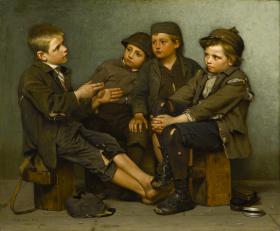1. Hold a brief class discussion focused on student perceptions of how Americans may have viewed labor, and child labor specifically, in the 1880s.
2. Assign the students to examine and analyze John George Brown's painting A Tough Story.
3. Continue the class discussion by asking the following questions:
- What are your feelings and emotions about the boys in the picture?
- What do you believe is the general attitude (atmosphere) of this painting?
- Do you believe the children in the painting are happy or unhappy? Why or why not?
- What do you think John George Brown wanted you to feel about these children?
- This and other paintings by Brown hung in the private homes of wealthy collectors. What impact do you think this painting might have had on its owner?
4. Assign the students to examine and analyze Lewis Hine's photographs.
- Italian Family Making Silk Flowers in New York, 1908
- Boy Lost Arm in a Saw in a Box Factory, 1909
- Child Picking Potatoes on Long Island, 1912
5. Have the students read some information on Hine and the captions that accompanied some of Hine's photographs.
6. Continue the class discussion focused on the following questions:
- How do these photos make you feel?
- What message is Hine communicating through his photographs and captions?
- How do Hine's photographic images differ from Brown's painting?
7. Assign the students to read a textbook description of child labor during the Progressive Era. Assign the students to write a one-page paper answering the following question: Which artist (Lewis Hine or John George Brown) do you think most effectively used art to change viewers' attitudes about child labor? What elements of their works communicated these views?
• The teacher will use class discussion and the paper to determine each student's understanding of how Lewis Hine and John George Brown helped influence Americans' response to child labor.
• Class discussion and the paper will be used to assess each student's analysis of images of child laborers and his or her interpretation of the intentions of those who made the images.
Progressive Era
Dijkstra, Bram. American Expressionism: Art and Social Change 1920–1950. New York: Harry N. Abrams, 2003.
Konzett, Delia Caparoso. Ethnic Modernisms: Anzi Yezierska, Zora Neale Hurston, Jean Rhys, and the Aesthetics of Dislocation. New York: Palgrave-Macmillan, 2002.
Pozzetta, George E. Nativism, Discrimination, and Images of Immigrants. New York: Taylor and Francis, 1991.
At the height of his career, in the 1880s and 1890s, the British-born J. G. Brown was probably the most popular and successful artist in America. He was especially praised for his depiction of working-class children. In the 1880s, New York swarmed with the children of the desperate poor. They were children robbed of their childhood, the sons and daughters of immigrants, many homeless and adrift in the teeming streets and alleys of lower Manhattan. However, in Brown's pictures, the squalor and viciousness of urban poverty is nowhere to be seen. Instead, the artist invented a sentimental fiction in which poor but honest and industrious youngsters elicit not our concern for their plight, but our admiration for their pluck.
This "rich man's fantasy" underlies A Tough Story, one of Brown's most engaging compositions. Posing the boys in his studio, the artist created a crisp, compelling narrative: three young bootblacks pause briefly in their work to listen intently to their barefoot friend's tale. Brown's straightforward, craftsman-like realism enhances the credibility of the scene; note the carefully observed details of the brushes and half-opened tin of polish. The name "Pat," carved into one boy's bootblack box, identifies the lad as Irish. Though dressed in rags, the boys are well scrubbed and well fed, appearing none the worse for the hard life they lead. As such, they were acceptable decoration for the parlors or picture galleries of polite New Yorkers who were doubtless reassured by this sentimental glimpse of the far-less fortunate.


